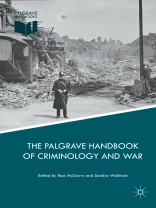This interdisciplinary Handbook brings together into one coherent volume a range of international authors, who firmly establish the relevance of war within the discipline of criminology. The chapters address emerging and prevailing issues in the criminological study of war, including state crime, corporate crime, victimology, genocide, policing, security and various forms of violence. Taking a critical standpoint including feminist, cultural, and radical approaches amongst others, the Handbook is split into five clear sections: (1) The Criminogenic Contexts of War; (2) Violence and Victimization at War; (3) Violence, War and Security; (4) Perpetrators of Violence and the Aftermath of War; and (5) Cultural and Methodological Developments for a Criminology of War.
Edited by two leading experts in the field, this Handbook provides an original point of reference on the contemporary debates and applications of criminology and war and will be a key resource for academics and students across criminology, international relations, critical military studies, military sociology, peace studies and law.
Daftar Isi
Introduction. The Criminology of War, What is it Good For?; Ross Mc Garry and Sandra Walklate.- Part I. The Criminogenic Contexts of War.- Chapter 1. War and Criminal Justice and the Rebirth of Privatisation; John Lea.- Chapter 2. Terrorism and War: Interrogating Discourses of Risk and Security; Gabe Mythen.- Chapter 3. Corporate War Crimes; Vincenzo Ruggiero.- Chapter 4. Criminology, War and Environmental Despoliation; Carmel O’Sullivan and Reece Walters.- Part II. Violence and Victimization at War.- Chapter 5. Genocide in the Context of War; Alex Alvarez.- Chapter 6. Sexual Violence During Armed Conflict; Christopher W. Mullins.- Chapter 7. Soldiers and Victims: Conceptions of Military Service and Victimhood, <1914-1945; Zoe Alker and Barry Godfrey.- Chapter 8. ‘I’m the Victim Here’: Intrastate Conflict and the Legacy of Political Violence; Neil Ferguson.- Chapter 9. Framing Blame and Victimhood in Post-Conflict Northern Ireland; Ruth Jamieson.- Part III. Violence, War and Security.- Chapter 10. Private Security Contractors as Criminals/Victims; Adam White.- Chapter 11. Police Pluralisation and Private Security; Ruth Delaforce.- Chapter 12. An Analysis of the War-Policing Assemblage: The Case of Iraq (2003-2015); Teresa Degenhardt.- Chapter 13. Violence, Policing and War; Jude Mc Culloch.- Part IV. Perpetrators of Violence and the Aftermath of War.- Chapter 14. The Dark Side of Defence: Masculinities and Violence in the Military; Ben Wadham.- Chapter 15. Imprisonment in Military Realms; Barry Goldson.- Chapter 16. Veterans, Crime and Criminal Justice Policy in England and Wales; Emma Murray.- Chapter 17. Should the Forces be in the Firing Line? Social Policy, the Veteran and the ‘Acceptable Face’ of Violent Criminality; James Treadwell.- Chapter 18. Lethal Innovation: The Nexus of Criminology, War and Malevolent Creativity; David H. Cropley.- Part V. Cultural and Methodological Developments for a Criminology of War.- Chapter 19. Cultural Criminology of War; Josh Klein.- Chapter 20. Reading Between the Lines: the Normalisation of Violence within Military Memoirs; Rachel Woodward and K. Neil Jenkings.- Chapter 21. Online Engagements: War and Social Media; Andrew Kirton.- Chapter 22. The Violence You Were/n’t Meant to See: Representations of Death in an Age of Digital Reproduction; Michael Mair, Chris Elsey, Paul V. Smith and Patrick G. Watson.- Conclusion. Taking Account of War, Making it Count; Sandra Walklate and Ross Mc Garry.
Tentang Penulis
Ross Mc Garry is Senior Lecturer in Criminology at the University of Liverpool, UK. He has written widely in international journals on criminology, victimology and critical military studies.
Sandra Walklate is Eleanor Rathbone Chair of Sociology at the University of Liverpool, UK, and is internationally recognised for her work in and around criminal victimisation particularly the fear of crime. In 2014, she received the British Society of Criminology’s award for outstanding achievement.












